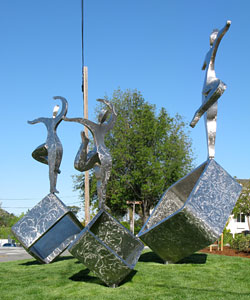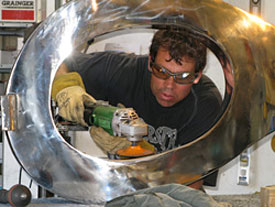Monumental Bronze: The Sculpture of Brian Chessmar
 Conviction. Silicone bronze sculpture. The finish uses no patina in order to celebrate the natural splendor of the bronze.
Conviction. Silicone bronze sculpture. The finish uses no patina in order to celebrate the natural splendor of the bronze. Photograph courtesy of Brian Chessmar
Brian Chessmar has always been involved in art as far back as grammar school. "I took pottery, freehand drawing and stained glass," says this bronze and steel sculptor based in Santa Barbara, California. "My mom was a potter and my dad painted," he says referencing the fact that he's been surrounded by the artistic bug since childhood. He lived in Paris between six and eight years old and the city's sculpture had a profound impact on his artistic vision.
Although he works primarily in metals today, his first venture into sculpture began in stone. "I just took to it," he says and it was 10 years before he transitioned into metal. "Bronze was the first metal I got into and learned to weld, and historically, bronze is the metal for sculpture." But it was that stone working, including an apprenticeship for two years, which taught him the business side of being an artist and gave him the confidence to eventually work for himself.
These days, Chessmar fabricates large format bronze and stainless steel sculptures in his 1,200 square foot studio located in an agriculture area of Santa Barbara. "I strive to do monumental work," he confesses, though he will do the occasional smaller work. But since the vast majority of his work is commissioned, his typical pieces are four feet tall and bigger, with price tags averaging $12,000. "My focus is to bring attention back to sculpture as a finely crafted object." His monumental pieces fuse geometric, organic and curvilinear forms, reflecting man's spiritual struggle.
 Brian Chessmar working in his studio.
Brian Chessmar working in his studio.Photograph courtesy of Brian Chessmar
Chessmar sources his 1/8th inch sheet bronze from the Alaskan Copper & Brass Company. "Bronze is a softer metal so you can clean up welds easier, and you can get more diverse patinas." He prefers bronze though for indoor pieces and he uses both hot and cold patinas. "You can warm up a clean piece of bronze and you'll get iridescent purple and blue colors, but I use the torch to heat up the bronze and that's what makes the chemical patinas bite into the metal, and where I get my colors," he says. He suggests getting bronze hot but not too hot, "like an iron," he says, otherwise if you apply too much heat you can burn the patina. He will then either seal the work with wax, or a clear coat. "You take a risk when you get a beautiful patina and you lacquer it; it has to be applied just right. If it's too thick it can get into the patina and ruin the color. I apply a thin light first coat, let that dry, then apply a heavier coat."
Chessmar has a number of commissioned pieces for private collectors, and public art fabrications for the City of San Luis Obispo, Santa Barbara City College, and the University of Southern California. He also has shown and installed his work in Minneapolis and Chicago. Galleries tend to be not practical in terms of his costs and upping the price of his work, a common refrain for many artists, but he is planning his own showroom in downtown Santa Barbara in the near future, in addition to promoting his bronze work on his website.
"I think all avenues are important to pursue," he says which is why he also applies for public competitions. Ultimately, his work, while monumental, is also immensely intimate. Qualities that will keep him busy for years to come.
Resources:
Also in this Issue:
- The Whimsical Way of Watchcraft
- Monumental Bronze: The Sculpture of Brian Chessmar
- Melinda Jacobson: Creating Beautiful Partnerships with Glass And Copperfoil
- Commemorative JFK Bronze Sculpture Unveiled in Fort Worth, TX
- Angie Simonsen: Unique Style Is The Foundation for Weirdly Wired Jewelry
